|
PATHFINDER
“I didn't start out to chart the skies; it's just
no one had done it before.”
Elrey B. Jeppesen
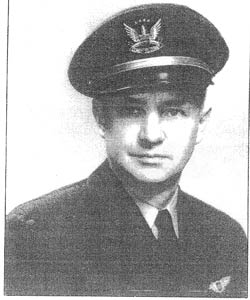 |
Born in Lake Arthur, LA on January 28, 1907, Elrey Jeppesen
landed once at Tucson on August 15, 1929 flying a Travel Air B-4000, S/N 1177. He had only been a pilot for two
years or so. He was based at Dallas, TX and his itinerary
as outlined in the Register was from Portland, OR to Santa
Monica, CA. He left nothing in the Register that suggested
the purpose for his solo trip.
However, his son Richard clarifies the itinerary (based on review of his father's pilot log books) as, "... Dallas, Midland, El Paso, Tucson, San Bernardino. This was after he had done photo work for Fairchild Aerial Surveys in Shrevport and New Orleans."
Not long after his landing at Tucson, “Jepp”,
as he was called, began a business that has had lasting and
fundamental impact on the aviation community to this day. His
legacy is in aerial navigation and the charting that pilots
use to fly from place to place.
Jeppesen learned to fly in 1927 after taking a ride with
a barnstormer in 1921 at Portland, OR. Just before
learning to fly, at age 18, he joined Tex Rankin’s
flying circus, first as a ticket seller, than as a prop twister
and wing walker. After he learned to fly, with his
$500 savings, he bought his first airplane, a surplus OX-5
Jenny. He
organized and operated his own flying circus in the Oregon-Washington
area.
During his learning period he also took courses in photography,
engineering and mathematics. He became adept at taking
pictures from his airplane. In 1928, when he was 21,
he worked for the Fairchild Aerial Surveys Company as manager
of their foreign photographic mapping division, based in
Mexico City.
Jeppesen's "Little Black Book"
 |
For two years he flew thousands of miles making the first
photo mappings of the Mexican coast from Brownsville, TX
to beyond the Yucatan Peninsula. Interestingly, at
least three of Fairchild Aerial Surveys’ airplanes
landed at Tucson. For example, see NR8016, NC9174,
and NC8006.
In 1930 he joined the Boeing Air Transport Company,
forerunner of United Airlines (UAL), as an airmail pilot with
the rank of captain. He flew routes like
Salt Lake City to Reno, Cheyenne to Salt Lake and Cheyenne
to Omaha. He also flew for UAL, and he is cited in the log books of fellow Register and UAL pilot Benton R. Baldwin (q.v. logbook number 4, April 29, 1936 to June 18, 1937, PDF page 2).
Jeppesen experienced the poor navigational system
that caused many pilots to become lost (four of the 20
Boeing pilots were killed in airplane accidents during
the winter of 1930). He purchased a notebook (left) in Cheyenne, carried it with
him on every flight, and jotted down particulars of airports
and terrain profiles. Armed with his notebook, Jepp
had an enviable record of completed flights. He recorded
field lengths, slope, drainage patterns, obstacles, airfield
layouts, telephone numbers of farmers who could provide weather
reports, and beacon and light information.
He had no idea of commercializing his concept; he was merely
collecting information for his own personal use as a pilot. He
went so far as to climb hills with an altimeter to obtain
accurate data about safe minimum altitudes for an airplane
crossing the area.
He measured the heights of smokestacks
and water towers in the vicinity of airports to establish
safe circling altitudes for himself. When radio ranges
were installed by the government in 1931-32, he flew all
legs of each installation and transcribed into his notebook
the safe letdown procedures for airports from Omaha and Cheyenne
to Salt Lake City and Oakland. An interesting aside here is that in 1932 Jeppesen touched the life of another Register airplane, Boeing NC842M. Please direct your browser to the link for further information.
Jeppesen's "Little Black Book"
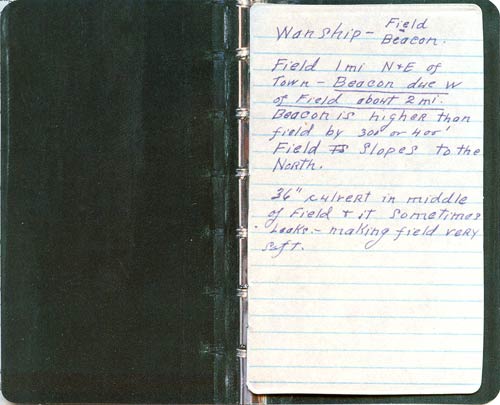 |
His “little black book” became popular among
early pilots. So much so that in 1934 he borrowed $450
and set up business in his basement in Cheyenne and published
the first of his Airway Manuals: fifty mimeographed copies
which sold out immediately for $10 each (don't forget, this
was in the middle of the Great Depression).
Jeppesen's "Little Black Book"
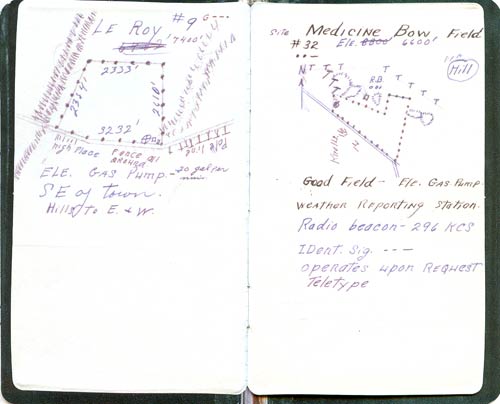 |
Over the next 20 years he built his charting business, and
worked as a transport pilot for United Airlines. He
had a busy career balancing his business and United responsibilities. His
business blossomed with WWII, as he was the only person in
the country with such a huge compilation of nationwide flying
information which was vital to national defense. The
Army used his manuals, and the Navy signed a contract with
his firm.
Jeppesen's "Little Black Book"
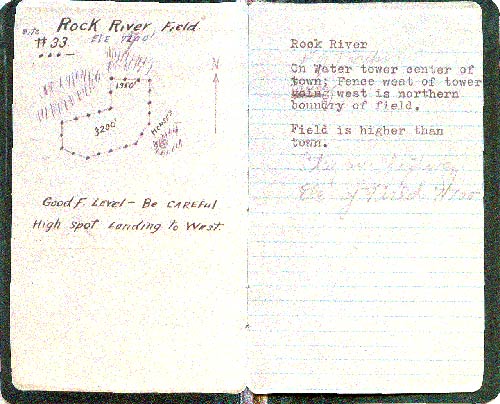 |
In 1954 he took early retirement from United to devote more
time to his expanding firm. By the end of the decade
he employed 200 people in a new building he had constructed
in Denver, CO. In 1961 he sold the firm to the Time
Mirror Publishing Company, but still remained as President
and then Chairman of the Board.
Jeppesen's "Little Black Book"
 |
On November 16, 1971 Jeppesen received the FAA’s distinguished
Service Award for outstanding contributions to the progress
and safety of aviation. His files then contained data
on millions of miles of charted airways, diagrams of 8,000
airfields, national weather interpretation and the latest
information on approach patterns and takeoff and landing
procedures, including communication and navigation frequencies
and obstacle avoidance information. The award citation
hailed him as, “…America’s pioneer charter
of airports and foremost mapper of skyways.”
Jeppesen's "Little Black Book"
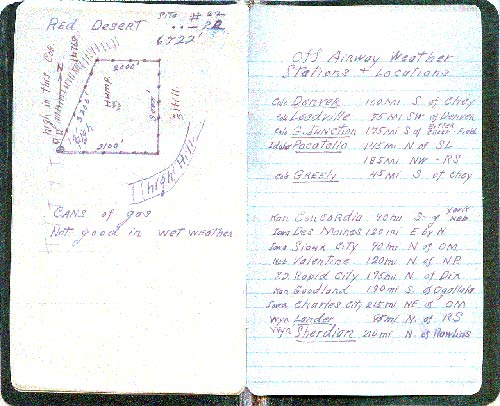 |
Jeppesen’s flying career spanned 50 years, three million
miles and 20,000 hours of flight time. Jeppesen
Sanderson, Inc. (a subsidiary of Boeing) survives today as the company
he founded, still compiling and publishing aerial navigational
aids for aviators. Nearly all U.S. commercial airlines
and many foreign airlines, as well as a large percentage
of instrument-qualified private, business and executive pilots,
use Jeppesen charts for enroute planning and guidance, as
well as for terminal approach procedures.
Jeppesen's "Little Black Book"
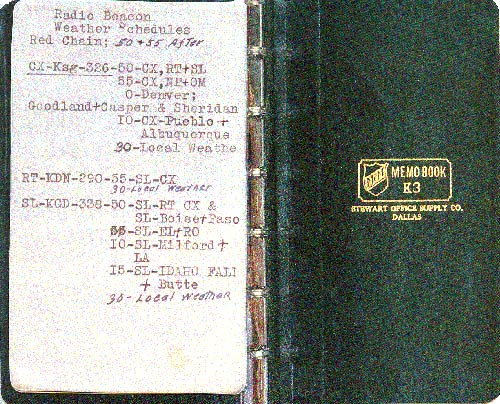 |
He leveraged his 10-cent notebook into a $121-million company
(as of 2005), and became a self-made millionaire in the process.
Pilot Jeppesen flew West on November 26, 1996. We can be
assured he did not get lost.
---o0o---
Update of April 23, 2009. Your Webmaster met and exchanged autographed books with Richard Jeppesen, son of our Register pilot Elrey B. Jeppesen.
Your Webmaster (L) with Richard Jeppesen, April 23, 2009, Lakeland, FL
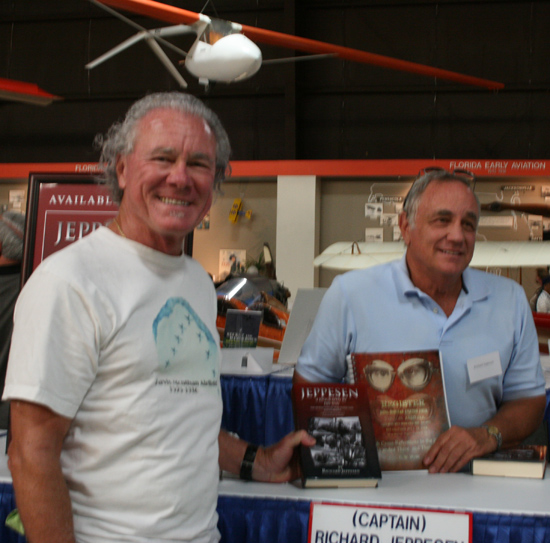 |
The venue of this meeting and exchange was the "Author's Corner" at the EAA Lakeland Museum. Your Webmaster holds Mr. Jeppesen's new biographical book about his father. Mr. Jeppesen holds the cross-referenced Register of the Davis-Monthan Airfield available at the link near the top of the left sidebar. You may order Richard Jeppesen's book at the link.
Pilot Jeppesen appeared in the Clover Field Register just two days before he landed at Tucson.
---o0o---
Dossier 2.1.104
UPLOADED: 06/03/07 REVISED: 01/15/08, 08/03/08, 02/15/09, 04/23/09, 07/30/09, 07/01/12
|










